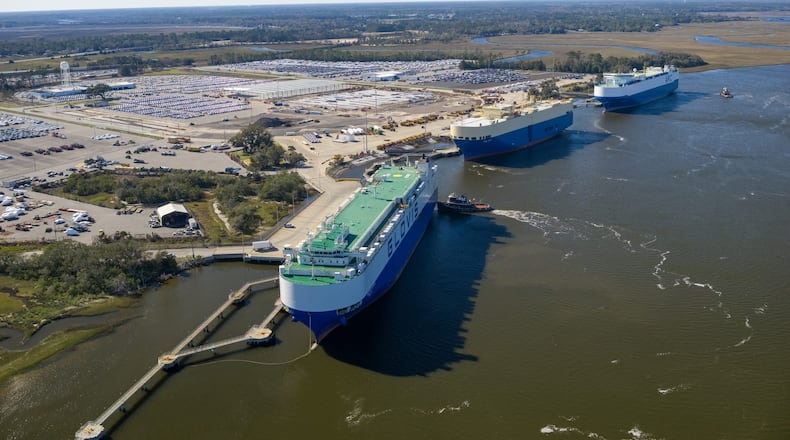Georgia ports expect this month to get about 17,000 extra units because of the bridge disaster that has closed the Port of Baltimore.
That means a 24% jump in vehicles and huge pieces of machinery on wheels coming to Georgia in April, with the lion’s share arriving in the Port of Brunswick, Grifford Lynch, chief executive of the Georgia Ports Authority, told the AJC Friday.
“In the short term it’s not a problem for us,” Lynch said. “The bigger question is how long is this going to go on?”
The shipments Baltimore specializes in are known as “Ro-Ro,” short for roll on-roll off. And only a few ports on the East Coast are prepared to handle them: Mainly, New York, New Jersey, Jacksonville and Brunswick.
Baltimore has been the No. 1 port for those shipments. The Port of Brunswick has been No. 2.
But on March 26, the 985-foot-long cargo ship Dali apparently lost power and crashed into a pylon supporting the Francis Scott Key Bridge. The bridge collapsed and eight workers — all immigrants from Mexico, Guatemala, Honduras or El Salvador — were filling potholes on the bridge when it collapsed. Only two survived.
A temporary, alternate channel for vessels was established, but it has been restricted to ships involved in clean-up. The Army Corps of Engineers hopes to open a limited-access channel for barge container ships and some vessels moving cars and farm equipment by the end of this month and to restore normal capacity to Baltimore’s port by May 31, the Associated Press reported.
Before the crash, up to $200 million in cargo typically moved each day through the Port of Baltimore, AP said.
With the port outlet effectively shuttered, materials and vehicles must be moved out of Baltimore by rail and trucking, according to Richard Rushforth, supply chain expert and assistant professor in the School of Informatics, Computing, and Cyber Systems at Northern Arizona University. So far, there haven’t been signs of bottlenecks, Rushforth said.
“I certainly think that trucking is much more flexible for moving goods,” he said. “I think it’s too early to tell about rail.”
More than a week after the bridge collapse, the scramble to adjust illustrates the lessons learned during the supply chain snarls during the pandemic, Rushforth said. “There hasn’t been as big a disruption as there maybe would have been 10 years ago.”
President Joe Biden took an aerial inspection of the disaster site and received updates from the Coast Guard and Army Corps of Engineers. He was expected to meet with the families of the victims.
Some experts say recovery will take at least $400 million and 18 months, according to AP.
Shortly after the bridge collapse, Biden said that the federal government will pay for the entire reconstruction cost. Pennsylvania Republican Rep. Dan Meuser called that promise “outrageous,” but Senate Republican Leader Mitch McConnell compared the situation to recovery spending after a natural disaster.
In 2007, after a highway bridge in Minneapolis collapsed and killed 13 people, Congress approved spending on recovery.
On Friday, Biden stood on the shore with the wreckage of the bridge behind him and pledged to rebuild.
“We’re going to move heaven and earth, to rebuild this bridge as rapidly as humanly possible,” he said. “We’re gonna do so with union labor and American steel.”
The Federal Highway Administration has provided $60 million in emergency relief funds to begin paying for clean-up and rebuilding. Biden has asked Congress to support recovery.
“I’m here to say your nation has your back and I mean it,” he said Friday. “Your nation has your back.”
Overall, Baltimore only ranks 11th in shipping traffic for containers, well behind Savannah, but it has also historically handled a huge number of vehicles and heavy machinery on wheels, cargo that can roll on and roll off. In that “Ro-Ro” traffic, Baltimore ranks first, handling more than 80,000 autos, light trucks and heavy machinery units each month.
No. 2 is the Port of Brunswick, which had been handling about 70,000 of those units, according to Lynch at the Georgia Ports Authority. “It would be tough for anyone to absorb all of Baltimore.”
But the burden cannot be spread evenly to all the ports on the East Coast, since only a few ports are prepared to handle that kind of shipments. Brunswick is one of them, so it may find itself asked to pick up more of the slack if the closure goes on.
Currently, the shipments being diverted to Georgia represent about one-fifth of the vehicles and machinery that Baltimore typically handles, Lynch said.
The port is in the midst of a $262 million expansion in anticipation of continued growth. Even without counting the shipments diverted from Baltimore, Brunswick this year has handled 18% more vehicles than in 2023.
The Georgia Ports Authority has been among the most forward-thinking among those who manage sea trade, said Glenn Richey, an expert on supply chain management in Auburn University’s Harbert College of Business. “The GPA has done a great job thinking ahead and building not only port capacity (in Brunswick) but also multi-modal options like the Colonel’s Island Terminal roll-on roll-off facility and additional added deep-water access.”
While it is hard to predict, if Baltimore’s port is not re-opened by May, the number of shipments to Brunswick will likely increase, said the GPA’s Lynch said. “We can do more than 20,000 a month, but could we double the capacity of Brunswick? No.”
Brunswick can process vehicles quickly, but the amount of vehicles Brunswick can handle depends on how quickly auto dealers and others move vehicles off the port’s property and free up space for more to arrive, he said. “There are just so many variables.”
The Associated Press contributed to this story
About the Author
Keep Reading
The Latest
Featured


